A Resource Guide by Andrew Fraknoi (Foothill College)
[Sep. 2013] updated Aug. 2016
A  PDF version of this document is also available for download (589KB).
PDF version of this document is also available for download (589KB).
© copyright 2016 by Andrew Fraknoi. The right to use or reproduce this guide for any nonprofit educational purposes is hereby granted. For permission to use in other ways, or to suggest additional materials, please contact the author at e-mail: fraknoi {at} fhda {dot} edu
The teaching of astronomy in our colleges and high schools often sidesteps the contributions of cultures outside of Europe and the U.S mainstream. Few educators (formal or informal) receive much training in this area, and they therefore tend to stick to people and histories they know from their own training -- even when an increasing number of their students or audiences might be from cultures beyond those familiar to them.
Luckily, a wealth of material is slowly becoming available to help celebrate the ideas and contributions of non-western cultures regarding our views of the universe.
Sponsored by the Higher Education Working Group within the NASA Science Mission Directorate, this listing of resources about cultures and astronomy makes no claim to be comprehensive, but simply consists of a range of English-language materials that can be used both by educators and their students/audiences. We include formally published and web-based materials, as well as videos and classroom activities.
While we have divided most of the guide by culture, for those just beginning their investigation, some of the general resources in the first section may be the best place to start. A separate guide to the contributions of women in astronomy is available. Suggestions for additions are welcome; please send them to the author at: <fraknoi {at} fhda.edu>.
Table of Contents:
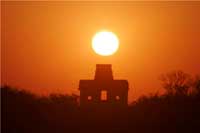
The Temple of the Sun at Dzibilchaltun in Yucatan, Mexico. The sun has risen on the spring equinox. On this day the Temple of the Sun frames exactly the rising sun. (Image Credit: Jim Spadaccini, Ideum)
1. General Resources on the Astronomy of Different Cultures
Published Materials:
Aveni, Anthony “Archaeoastronomy: Past, Present and Future” in Sky & Telescope, Nov. 1986, p. 456.
A quick overview.
Aveni, Anthony Conversing with the Planets. 1992, Times Books. Celebrates the traditions of many cultures; emphasizes the importance of seeing them in their own context.
Aveni, Anthony Empires of Time. 1989, Basic Books. A discussion of calendars, clocks, and cultures, with chapters on the Maya, Aztecs, Incas, Ancient Chinese, and several other early civilizations.
Aveni, Anthony Stairways to the Stars: Skywatching in Three Great Ancient Cultures. 1997, John Wiley. Focuses of the monuments and astronomy of the people who built Stonehenge, plus the Maya and the Inca.
Gleiser, Marcelo The Dancing Universe: From Creation Myths to the Big Bang. 1997, Dutton/Penguin. An exploration by a physicist of ideas from many cultures of how the universe came to be, including ancient legends and modern science.
Hadingham, Evan Early Man and the Cosmos. 1984, Walker & Co. A clear primer on the subject of ancient sites and the astronomical thinking of ancient cultures around the world.
Kelley, David & Milone, Eugene Exploring Ancient Skies: A Survey of Ancient and Cultural Astronomy, 2nd ed. 2011, Springer. A textbook for a course at the University of Calgary, this volume compiles a lot of information from different cultures.
Krupp, Edwin Beyond the Blue Horizon: Myths and Legends of the Sun, Moon, Stars, and Planets. 1991, HarperCollins. Superb collection of astronomical tales from many cultures. Best book to start with.
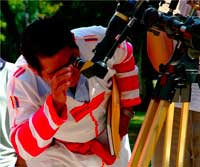
Maya official from the town of Oxchuc, Chiapas, attired in traditional dress from his town, observes the Sun through a special telescope. (Image credit: Igor Ruderman, UC Berkeley)
Krupp, Edwin Skywatchers, Shamans, & Kings: Astronomy and the Archaeology of Power. 1997, J. Wiley. Fine guide to sites around the world, written for beginners with humor and verve.
Krupp, Edwin Echoes of the Ancient Skies: The Astronomy of Lost Civilizations. 1983, Harper & Row. An excellent introduction on the thoughts and monuments of earlier cultures.
Penprase, Bryan The Power of the Stars: How Celestial Observations Have Shaped Civilization. 2011, Springer. Good non-technical introduction to the myths, constellation, calendars, astronomical buildings, and world views of various cultures.
Ruggles, Clive Ancient Astronomy: An Encyclopedia of Cosmologies and Myth. 2005, ABC-Clio. Mammoth A-Z compilation of the ancient knowledge of a wide range of cultures.
Walker, Christopher, ed. Astronomy Before the Telescope. 1996, St. Martin’s Press. 17 essays on how people observed and interpreted the sky before modern instruments.
Zeitlin, Steve The Four Corners of the Sky: Creation Stories and Cosmologies from Around the World. 2000, Henry Holt. Short book introducing and retelling the stories.
Websites and Articles on the Web:
Ancient Observatories, Timeless Knowledge from the Stanford Solar Center (An introduction to ancient sites where the movements of celestial objects were tracked over the years, with a special focus on tracking the Sun.): http://solar-center.stanford.edu/AO/
Astronomy Before History by Clive Ruggles and Michael Hoskin (from the Cambridge Concise History of Astronomy) -- a nice pdf file with a well-written introduction to ancient astronomy: http://assets.cambridge.org/052157/2916/sample/0521572916web.pdf
The Center for Archaeoastronomy at the University of Maryland (Good site to learn more about the serious study of the astronomical relics of ancient cultures; some parts for the public, some for professionals in the field): http://www.wam.umd.edu/~tlaloc/archastro/
Cultural Astronomy Web Exhibit (Modules and resources on many cultures that have an astronomical tradition, created with the assistance of Chicago’s Adler Planetarium): http://ecuip.lib.uchicago.edu/diglib/science/cultural_astronomy/
An Introduction to Archaeoastronomy (Clive Ruggles’ 2003 Introductory Course Notes and Images at the University of Leicester): http://www.le.ac.uk/archaeology/rug/aa/a3015/index.html
Multicultural Cosmology Education Resource Center at Pomona College (Bryan Penprase and his collaborators have made this useful introductory site, which includes a world atlas of ancient astronomy, course outlines, a timeline and links to other resources): http://www.astronomy.pomona.edu/archeo/intro.html
Heritage Sites of Astronomy and Archaeoastronomy in the Context of the World Heritage Convention (a full report on how to preserve important sites in the history of astronomy around the world, with examples from many cultures): http://www2.astronomicalheritage.net/index.php/thematic-study-content
Orion by Philip Glass (a musical composition created for the 2004 Olympics which is based on the mythology of Orion in a variety of cultures from around the world): http://www.philipglass.com/music/compositions/orion.php
Solar Folklore from the Stanford Solar Center (Myths and legends about the Sun from cultures around the world): http://solar-center.stanford.edu/folklore/
Traditions of the Sun (The NASA Sun-Earth Connection Education Forum site offers virtual visits to n astronomical sites and Chaco Canyon placed in appropriate historical, cultural, and scientific contexts): http://www.traditionsofthesun.org/
The Dec. 2007 issue of the Journal for Geoscience Education was devoted to broadening participation in the earth sciences: http://www.nagt.org/nagt/jge/abstracts/dec07.html
Classroom Activities:
Indiana Jones and the Astronomy of Yore (Issue of the Astronomical Society of the Pacific newsletter on teaching astronomy, by Louis Winkler, focusing on archaeaoastronomy): http://www.astrosociety.org/education/publications/tnl/31/31.html
Using Multicultural Dimensions to Teach Astronomy (by Nalini Chandra and John Percy): http://www.astrosociety.org/education/publications/tnl/53/multicultural.html
Some Technical Volumes:
Aveni, Anthony World Archaeoastronomy. 1989, Cambridge University Press. Proceedings of an international conference held in 1986, collecting scholarly work on the sites and monuments in many regions.
Batten, Alan, ed. Astronomy for Developing Countries. 2001, International Astronomical Union. Published by the Astronomical Society of the Pacific (www.astrosociety.org). Describes the many challenges of starting or continuing astronomy programs in countries without an extensive science infrastructure.
Chamberlain, Von Del, et al, eds. Songs from the Sky: Indigenous Astronomical and Cosmological Traditions of the World. 2005, Ocarina Books. Proceedings of a 1983 international conference on ethnoastronomy (OK, so it took a while to publish). 32 papers about the sky knowledge, folklore and art of cultures around the world.
Ruggles, Clive & Saunders, Nicholas, eds. Astronomies and Cultures. 1993, University Press of Colorado. Papers about Chinese, Japanese, Islamic, and Mesoamerican cultures.
Selin, Helaine, ed. Astronomy Across Cultures: The History of Non-western Astronomy. 2000, Kluwer. A series of scholarly articles on the ancient astronomical traditions and monuments of a wide range of cultures.
Williamson, Ray & Farrer, Claire, eds. Earth and Sky: Visions of the Cosmos in Native American Folklore. 1992, University of New Mexico Press. Collection of essays.
David Dearborn’s bibliography of technical and nontechnical readings in archaeoastronomy can be found at: http://archaeology.about.com/od/archaeoastronomy/a/dearborn_bib.htm
2. Astronomy of African-American and Hispanic-American Cultures
Published Materials:
Bedini, Silvio The Life of Benjamin Banneker: The First African-American Man of Science, 2nd ed. 2009, Maryland Historical Society.
Ferris, Jeri What Are You Figuring Now?: A Story about Benjamin Banneker. 1988, Carolrhoda Books. Children’s book about 18th century black astronomer, mathematician, surveyor.
Norman, D., “Expanding Diversity in Professional Astronomy” in Sky & Telescope, Feb. 2010, p 86. A powerful editorial on what needs to be done.
Oluseyi, H. & Urama, J. “Participation and Research of Astronomers… of Black African Descent (1900-2005)” in Holbrook, Jarita, et al., eds. African Cultural Astronomy. 2008, Springer.
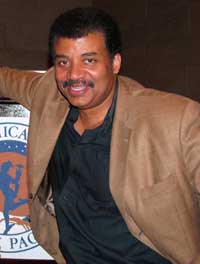
Neil deGrasse Tyson
Price, J., et al. “American Minorities in Astronomy: Some Gains, A Long Way to Go” in Mercury (the magazine of the Astronomical Society of the Pacific), May/June 1995, p. 11. Multi-author report, with some poignant anecdotal notes.
Rall, Gloria “The Stars of Freedom” in Sky & Telescope, Feb. 1995, p. 36. On how slaves used songs with the Big Dipper to show them escape routes from the South.
Sakimoto, Phil & Rosendhal, Jeff “Obliterating Myths about Minority Institutions” in Physics Today, vol. 98, #9, pp. 49-53 (September 2005). The authors, formerly the heads of NASA’s space science education and public outreach program, offer some frank comments about the task of developing space science programs at minority colleges and universities.
Stassun, Keivan “Building Bridges to Diversity” in Mercury, May/June 2005, p. 20. The Chair of the Committee on the Status on Minorities in Astronomy for the American Astronomical Society discusses what could be done to increase the number of minority astronomers.
Tyson, Neil deGrasse The Sky is Not the Limit: Adventures of an Urban Astrophysicist. 2004, Prometheus. An autobiography of the beloved public astronomer, with a section discussing racism.
“Have Minorities Broken Astronomy’s Glass Ceiling” -- a roundtable in Astronomy magazine, May 2003, pp. 55-58.
Websites and Articles on the Web:
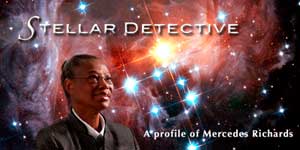
Mercedes Richards
Eshleman, Adams “Mercedes Richards: Stellar Detective” (Penn State University news story 2009): http://news.psu.edu/story/141653/2009/08/05/
research/stellar-detective-profile-professor-mercedes-richards
Follow the Drinking Gourd Guide (about how slaves used a song about the Big Dipper to find their way North in the U.S.; note however, the next reference in our list for some doubts about the modern song’s antiquity):
http://www.math.nus.edu.sg/aslaksen/gem-projects/hm/0203-1-20-follow/drinkinggourd/decoding.html
Follow the Drinking Gourd Website: http://www.followthedrinkinggourd.org/ An amateur music scholar has researched the history of the song about the Big Dipper more thoroughly and presents his work here. See especially, his teachers’ guide at: http://www.followthedrinkinggourd.org/Appendix_Teachers_Guide.htm
Fikes, R. “From Banneker to Best: Some Stellar Careers in Astronomy and Astrophysics” (about African-American astronomers): http://www.math.buffalo.edu/mad/special/Black.Astronomers-Fikes.pdf
Greene, N. “African-Americans in Astronomy and Space (a concise guide with links to brief biographies of each): http://space.about.com/od/astronomyspacehistory/tp/Black_History_Month.htm
Holbrook, J. “Survival Strategies for African-American Astronomers and Astrophysicists” (six strategies gathered from interviews): http://arxiv.org/pdf/1204.0247
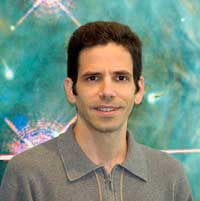
Jose Francisco Salgado
Norman, D. et al. “Increasing the Number of Underrepresented Minorities in Astronomy at the Undergraduate, Graduate, and Postdoctoral Levels” (a 2010 position paper): http://www.aura-astronomy.org/diversity/
documents/Norman_minoritypaperI_DEM_EPO.pdf
Who are the Black Astronomers and Astrophysicists? (profiles of 20th and 21st century African-American astronomers): http://www.math.buffalo.edu/mad/physics/astronomy-peeps.html
Tyson, Neil deGrasse: 2004 Interview on the PBS NOVA website, covering not only astronomy but his development as a scientist and facing racism: http://www.pbs.org/wgbh/nova/space/conversation-with-neil-tyson.html
Article about the Bridge Program that Mexican-American astronomer Keivan Stassun is leading to increase the number of Latino PhD’s: http://nbclatino.com/2012/07/24/vanderbilt-university-program-bridges-latinos-to-phd-degrees/
Profile of Jose Francisco Salgado, astronomer and educator, born in Puerto Rico: http://nbclatino.com/2012/07/03/an-astronomer-who-urges-not-to-have-limits/
Astrophysics Circle of Puerto Rico (highlights the life and work of a number of Puerto Rican astronomers): http://astrocircle.org/
Profiles of astronomers on the History Makers website:

Gibor Basri
Gibor Basri: http://www.thehistorymakers.com/biography/gibor-basri-41
George Carruthers: http://www.thehistorymakers.com/biography/george-carruthers-41
William Jackson: http://www.thehistorymakers.com/biography/william-jackson
Derrick Pitts: http://www.thehistorymakers.com/biography/derrick-pitts
Interview with Claudia Alexander on the Women in Planetary Science web site: http://womeninplanetaryscience.wordpress.com/2011/02/03/claudia-alexander-be-prepared-to-be-flexible-in-your-career/
“Jarita Holbrook: A Guiding Star” (nice profile of her life and work): http://sciencecareers.sciencemag.org/career_magazine/previous_issues/articles/2007_06_01/caredit.a0700079
“Rise of a Gangsta Nerd:” An Interview with Hakeem Oluseyi (about his life and work): http://blog.ted.com/2012/10/05/rise-of-a-gangsta-nerd-fellows-friday-with-hakeem-oluseyi/
Lawrence, Star “Hispanic Astrophysicist and Educator Boosts Women in Science” (a 2005 profile of Tania Ruiz): http://sciencecareers.sciencemag.org/career_magazine/previous_issues/articles/2005_03_04/
nodoi.3021632384592204282
Committee on the Status of Minorities (AAS) Web site: http://csma.aas.org/ Discussions of and resources about minority issues in the training of professional astronomers in the U.S. See, in particular, their very useful SPECTRUM newsletter: http://csma.aas.org/spectrum.html
“Women of Color in Astronomy & Astrophysics” (a 2012 White Paper): http://womeninastronomy.blogspot.com/2015/01/women-of-color-in-astronomy-and.html
The National Association of Black Physicists has a blog called “Vector” and you can isolate just those posts that are connected with astronomy at: http://vector.nsbp.org/category/astronomy-and-astrophysics-astro/
Videos:
Hubble’s Diverse Universe (a video about the research of African-American and Hispanic-American astronomers & astrophysicists) [1 hr. 52 min]: https://www.createspace.com/410482
Reaching to the Stars: African American Astronomers (in celebration of Black History Month in 2011, Swarthmore hosted three African-American scientists: Derrick Pitts (Fels Planetarium), Eric Wilcott (U. of Wisconsin) and astronaut Mae Jemison, discussing the future of the field.) [90 min]: http://www.youtube.com/watch?v=9q8I3bU68Gw
A Story about Race (Neil deGrasse Tyson reflects on cultural issues that arose during his college and graduate years) [12 min]: https://www.youtube.com/watch?v=eQLtPWPqsjA
Hakeem Olusey “Star Search,” an autobiographical talk at the Chicago Humanities Festival in 2014 [56 min]: https://www.youtube.com/watch?v=GRhgNw1siUo
3. Astronomy of Native North American Cultures
Published Materials:
Bol, Marcia, ed. Stars Above, Earth Below: American Indians and Nature. 1993, Carnegie Museum of Natural History. Collection of essays describing how indigenous groups examine the natural world, with a chapter on astronomy.
Canby, T. “The Anasazi: Riddles in the Ruins” in National Geographic, Nov. 1982, p. 554.
Carlson, J. “America’s Ancient Skywatchers” in National Geographic, vol. 177, #3, Mar 1990, p. 76.
Dempsey, Frank “Aboriginal Sky Lore of the Pleiades Star Group in North America” in Journal of the Royal Astronomical Society of Canada, vol. 103, p. 233 (2009).
Dempsey, Frank “Aboriginal Sky Lore of the Constellation Orion in North America” in Journal of the Royal Astronomical Society of Canada, vol. 103, p. 65 (2009).
Dempsey, Frank “Aboriginal Sky Lore of the Big Dipper in North America” in Journal of the Royal Astronomical Society of Canada, vol. 102, p. 59 (2008).
Krupp, E. “Whiter Shade of Pale” in Sky & Telescope, July 2000, p. 86. A rock that looks like the Milky Way and was used in ceremonies by Native Americans in California.
MacDonald, John The Arctic Sky: Inuit Astronomy, Star Lore and Legend. 1998, Royal Ontario Museum. Astronomical stories and explanations from Northern Canada and Alaska, including a discussion of interpretations of the aurora.
Malville, J.M. & Putnam, Claudia Prehistoric Astronomy in the Southwest. 1993, Johnson Books. A nice introductory book about cultures and monuments in the Arizona area.
Maryboy, Nancy & David Begay Sharing the Skies: Navajo and Western Cosmos. 2006, Indigenous Education Institute & World Hope Foundation (available from Amazon.com). An authoritative compilation by Navajo and Western astronomers of illustrations, stories, and observations of Navajo constellations coupled with stories from corresponding Greek constellations and Hubble Space Telescope images of objects found in that part of the sky. This is a kit that includes an audio CD, a small poster of the Diné Universe, and learning activities.
Mayo, Gretchen Star Tales: North American Indian Stories. 1991, Walker & Co. A book of traditional stories for kids. (See sequel, More Star Tales, from same publisher.)
McLeary, Timothy The Stars We Know, 2nd ed. 2012, Waveland. An examination of the astronomy in the traditions and world view of the Crow people.
Miller, Dorcas Stars of the First People: Native American Star Myths and Constellations. 1997, Pruett.
Monroe, Jean & Williamson, Ray They Dance the Sky: Native American Star Myths. 1987, Houghton Mifflin. Skylore from a number of tribes retold.
Schulz, T. “Mask of Black God: The Pleiades in Navajo Cosmology” in Journal of College Science Teaching, Oct. 2005, p. 30.
Williamson, Ray Living the Sky: The Cosmos of the American Indian. 1984, Houghton Mifflin/University of Oklahoma Press. The sky world of the Native Americans, through their tales and their observing sites.
Websites and Articles on the Web:
Aboriginal Star Knowledge: Native American Astronomy: http://www.kstrom.net/isk/stars/starmenu.html
American Indian Starlore (compiled by Brad Snowder, Western Washington U.): http://www.wwu.edu/depts/skywise/legends.html
Exploratorium Chaco Canyon Site: http://www.exploratorium.edu/chaco/index.html
Garmany, Catharine Resources for Astronomy Outreach Providers and Teachers of Native Americans (helpful ideas and materials, from the National Optical Astronomy Observatories): http://www.noao.edu/education/nativeamerican/
Profile of Native American astronomer Dennis Lamenti: http://indiancountrytodaymedianetwork.com/2011/08/07/native-astronomer-46049
Lamenti’s Obituary (AAS site): https://aas.org/obituaries/dennis-j-lamenti-1958-2012
Resource Guide for Canadian Aboriginal Astronomy (by Prune Harris): http://www.integrativescience.ca/uploads/articles/2010May-Harris-Canadian-Aboriginal-astronomy-resource-list(in-press).pdf
Solar Astronomy in the Pre-historic Southwest (P. Charbonneau, et al): http://www.hao.ucar.edu/education/archeoslides/slide_1.php
Star Map and Sky Lore of the Ojibwe Native American People (compiled by Annette Lee): http://web.stcloudstate.edu/aslee/OJIBWEMAP/home.html (Note sometimes in the US the Ojibwe were referred to as Chippewa)
Videos:
Animated story of “Coyote and Eagle Steal the Sun and Moon” (from Zuni tradition) [~2 min]: http://www.youtube.com/watch?v=EwyVDadt7QE
Annette Lee (a Native American astronomer discusses her personal development and work in the astronomy of native cultures in this brief video; hers is not the first one you come to, but just go down the page): http://www.northstarstem.org/about
“Grandmother Spider Brings the Sun to the Earth” (from the Cherokee tradition, told by Elaine Cohen) [~9 min]: http://www.youtube.com/watch?v=rNBNGL9uLCI (A shorter version is at: http://www.youtube.com/watch?v=rbTkP0gbNGQ )
NASA Connect: Indigenous Astronomers (a segment of NASA Connect’s Ancient Observatories episode follows Native American educators Nancy Maryboy and David Begay as they show examples of structures used to track the sun in the sky) [~7 min]: http://archive.org/details/NasaConnect-Ao-IndigenousAstronomers
Classroom Activities:
Ancient Eyes Looked to the Skies: Sunwatchers of the Southwest (Activities in Archaeoastronomy for the Classroom, Grades 4-8, from the Chabot Science Center): http://www.chabotspace.org/assets/teacher/sunwatchers.pdf
Time-telling activity that incorporates Navajo culture and history (for grades 3 – 5): http://www.teachervision.fen.com/tv/printables/allynbacon/Ward_020551409x_104-109.pdf
4. Astronomy of African Cultures
Published Materials:
DeVries, Dan “Teaching Across Cultures” in Mercury (the magazine of the Astronomical Society of the Pacific), Jul/Aug. 2005, p. 12. A physicist recounts his experience teaching science in Botswana.
Doyle, Laurence and Frank, Edward “Astronomy of Africa” in Encyclopaedia of the History of Science, Technology and Medicine in Non-Western Cultures. Edited by H. Selin (2008, Springer)

Jarita Holbrook
Holbrook, Jarita, et al., eds. African Cultural Astronomy. 2008, Springer. A variety of papers with much useful information.
Holbrook, Jarita “Sun Gods and Moon Deities of Africa” in Campion, N. & Curry, P., eds. Sky and Psyche. 2006, Floris Books.
Kreamer, Christine African Cosmos: Stellar Arts. 2012, Monacelli Press. Book of essays on African views of the skies, compiled for an exhibit at the National Museum of African Art.
Schilling, G. “The Star-Pyramid Connection” in Mercury, Jul/Aug. 2001, p. 28. On the Egyptian pyramids and their astronomical orientation.
Snedegar, Keith “Ikhwezi is the Morning Star” in Mercury, Nov/Dec. 1997, p. 12. On African myths related to the sky.
Websites and Articles on the Web:
The Dogon Tribe and the so-called “Sirius Mystery”: http://www.ramtops.co.uk/dogon.html and http://chandra.harvard.edu/chronicle/0400/sirius_part2.html
Holbrook, Jarita “African Astronomy”: http://www.wam.umd.edu/~tlaloc/archastro/ae28.html A brief overview of astronomical ideas in African tradition.
Wines, M. “In South Africa, Telescope Could Stir Young Scholars” (Apr. 7, 2006 NY Times article that discusses the challenges faced by African astronomers): http://www.nytimes.com/2006/04/07/world/africa/07sutherland.html?_r=2&oref=slogin&
Video:
Cosmic Africa (a film about African astronomer Thede Medupe, who looks into the astronomical legends of African cultures) See an article at: http://www.creardon.com/archives/FFR/FFR42.html and purchase a video at: http://www.africanfilmny.org/2011/cosmic-africa/
Ancient Astronomers of Timbuktu (a video and website on the project to preserve the papers and knowledge of this Saharan city.) The website: http://www.scribesoftimbuktu.com To purchase the video, go to: http://www.planetarium.co.za/ and scroll down to the items that can be purchased from the planetarium book store. (For more on the video, also see: http://www.planetarium.co.za/Timbuktu/Anc%20Astro%20of%20Tim-USE.pdf )
Ancient Astronomers of Timbuktu (A description of the project: http://www.planetarium.co.za/Timbuktu/Anc%20Astro%20of%20Tim-USE.pdf ) To see the first seven minutes, go to: https://vimeo.com/30076774
Classroom Activity:
Lawrence Hall of Science African Mythology Curriculum Guide (although originally developed for the STARLAB portable planetarium, some of these activities can be adapted for classroom use): http://cdn5.starlab.com/wp-content/uploads/2012/02/D.7.AfricanMythology.pdf
5. Astronomy of Islamic Cultures
Published Materials:
Ahmad, I. & Khalid Shaukat, S. “Muslim Moon Sightings” in Mercury (the magazine of the Astronomical Society of the Pacific), May/June 1995, p. 38. The Muslim calendar and sighting the first crescent moon.
Gingerich, Owen “Islamic Astronomy” in Scientific American, April 1986, vol. 254, p74. (Available on the web at: http://faculty.kfupm.edu.sa/PHYS/alshukri/PHYS215/Islamic_astronomy.htm)
King, David A., “Mathematical Astronomy in Islamic Civilization,” in Selin, H., ed. Astronomy Across Cultures: The History of Non-Western Astronomy. 2000, Kluwer Academic Publishers, pp. 585-613.
King, David A. In Synchrony with the Heavens, Studies in Astronomical Timekeeping and Instrumentation in Medieval Islamic Civilization. 2005, Brill Publishers. Multi-volume, authoritative study.
Saliba, George. A History of Arabic Astronomy: Planetary Theories during the Golden Age of Islam. 1994, New York University Press. A scholarly history.
Web Sites and Web Articles:
Arab and Islamic Astronomy (Leslie Welser): http://www.starteachastronomy.com/arab.html
The Role of Astronomy in Islam (Dr. Shirin Haque-Copilah): http://moonsighting.com/articles/roleofislam.html
Records of Eclipses in Muslim Astronomy: http://www.muslimheritage.com/topics/default.cfm?ArticleID=810
The Islamic Calendar: http://www.math.nus.edu.sg/~mathelmr/calendar/islamic.shtml
Ridpath, Ian: “Al-Sufi’s Constellations”: http://www.ianridpath.com/startales/alsufi.htm
Predicting the First Visibility of a Lunar Crescent Site (not specifically about Islamic astronomy, but more about the techniques and practice of sighting the crucial astronomical sign of a month’s beginning; some easy, some technical): http://www.staff.science.uu.nl/~gent0113/islam/islam_lunvis.htm
Also see: http://www.saao.ac.za/public/viewing-the-sky/moon/lunar-crescent-visibility/ and http://www.icoproject.org/?&l=en
UNESCO: “Islamic Astronomy” (part of the Portal to the Heritage of Astronomy Site): http://www2.astronomicalheritage.net/index.php/show-theme?idtheme=15
Bibliography on the Astronomy of Baghdad in the 9th and 10th centuries by David A. King: http://www.muslimheritage.com/article/renaissance-astronomy-baghdad-9th-and-10th-centuries
Video:
Video of a talk by Dr. George Saliba on the role of Arabic/Islamic astronomy in medieval and Renaissance culture (1 hr. 25 min): http://www.youtube.com/watch?v=ZsJ4Zrf8miA
6. Astronomy of Central and South American Cultures
Published Materials:
Aveni, Anthony “Emissaries to the Stars: The Astronomers of Ancient Maya” in Mercury (the magazine of the Astronomical Society of the Pacific), Jan/Feb. 1995, p. 15.
Aveni, Anthony The End of Time: The Maya Mystery of 2012. 2009, University Press of Colorado. A fine introduction to Maya astronomy and debunking of the notion that their calendar means the end of the world in 2012.
Aveni, Anthony Skywatchers. 2001, U. of Texas Press. An updated version of Skywatchers of Ancient Mexico, this is an introduction to the astronomy of the Maya.
Aveni, Anthony Between the Lines: The Mystery of the Giant Ground Drawings of Ancient Nasca, Peru. 2000, U. of Texas Press.
(See also some of the books by Aveni in section 1 of this guide.)
Barnhart, Edwin “Reconstructing the Heavens: Archaeoastronomy and the Ancient Maya World” in Mercury, Jan/Feb. 2004, p. 20. The Mayan calendar, sky observations, and monuments.
Bauer, Brian & David Dearborn Astronomy and Empire in the Ancient Andes. 1995, U. of Texas Press. Examines the role of astronomy among the Incas.
Kurtz, P. “An Astronomer Reads Archeology’s Message” in Astronomy, Oct. 2002, p. 48. Profile of Anthony Aveni, with a focus on his work on Mayan structures.
Milbrath, Susan Star Gods of the Maya: Astronomy in Art, Folklore, and Calendars. 2000, University of Texas Press. Scholarly monograph.
Van Stone, Mark Science and Prophecy of the Ancient Maya. This self-published book by a Maya expert addressed the issue of whether the Maya predicted Doomsday in 2012, but also has material on their astronomical and calendar systems, See: http://markvanstone.com/books/
Websites and Articles on the Web:
The Maya Astronomy Page (Dawn Jenkins): http://www.michielb.nl/maya/astronom.html
Maya Exploration Center (Dr. Edwin Barnhart): http://www.mayaexploration.org/ Includes tours of sites, resources, interviews, etc.
Calendar in the Sky (connects Maya knowledge to modern astronomy; produced by the education group at the Berkeley Space Sciences Lab): http://www.calendarinthesky.org/
Mark Van Stone’s “It’s Not the End of the World: What the Ancient Maya Tell Us About 2012” (a detailed analysis): http://www.famsi.org/research/vanstone/2012/index.html (Also, see his illuminating FAQ: http://www.famsi.org/research/vanstone/2012/faq.html )
“Tales of Wandering Stars” (A tale from Inca Mythology, about the planets by Germán Puerta Restrepo): http://unawe.org/resources/education/tales_of_the_wandering_star_eng/
The Birth of Venus (A traditional Aztec story, by Marcos Carías): http://unawe.org/resources/education/birth_of_venus_eng/
Traditions of the Sun: Explore the World’s Ancient Observatories (includes tours of Maya sites and traditions): http://www.traditionsofthesun.org/
Video:
Maya Astronomy and Mathematics (from NASA Connect, with Sten Odenwald) [8 min]: http://www.youtube.com/watch?v=5W9zFwBQb6c
Anthony Aveni on “The End of Time” at Marlboro College (on the Mayan calendar and why the world will not end in 2012; delivered 9/13/2010; 1 hr 2 min): http://www.youtube.com/watch?v=exQGTvZ5aKw
“Why We Will Still Be Here on Dec. 21 [2012]” (a panel on the predictions of Doomsday 2012, with information on the Maya calendar by E.C. Krupp; recorded in 2012 at the SETI Institute): http://www.youtube.com/watch?v=WA5FC0in6U8
Classroom Activities:
Calendar in the Sky Lesson Plans: http://www.calendarinthesky.org/MultimediaResources/LessonPlans.aspx
Activity from NOVA to figure out your birthday in the Maya calendar (if you were born 1980 or after): http://www.pbs.org/wgbh/nova/teachers/activities/pdf/2804_maya.pdf
Online Maya Calendar Converter: http://www.mayaskies.org/mayacalendar.html
Educational Activities Accompanying the Tales of the Maya Skies planetarium show: http://mayaskies.org/onlineactivities.html
7. Astronomy of Hawaiian, Polynesian, and Native Australian Cultures
Published Materials:
Bryan, E.H. & Crowe, Richard Stars Over Hawaii, 2nd ed. 2002, Petroglyph Press (available from BasicallyBooks.com). An introduction to the stars as seen from Hawaii and their use as navigation aids in traditional Hawaiian voyaging.
Finney, Ben Hokule’a: The Way to Tahiti. 1976, Dodd Mead. An anthropologist describes recreating the voyages of the ancient Polynesians using the stars to navigate. Updated in his Sailing in the Wake of the Ancestors: Reviving Polynesian Voyaging. 2004, Bishop Museum Press.
Haynes, R. “Dreaming the Sky” in Sky & Telescope, Sep. 1997, p. 72. On the astronomical ideas in Australian aborigines culture.
Kyselka, Will & Ray Lanterman North Star to Southern Cross. 1976, University of Hawai‘i Press. A geologist and planetarium educator recounts how he became part of the project to rediscover the ancient art of navigating by the stars and a voyage to see how it was done.
Makemson, Maud The Morning Star Rises: An Account of Polynesian Astronomy. 1941, Yale University Press.
Websites and Articles on the Web:
Australian Aboriginal Astronomy: http://www.atnf.csiro.au/research/AboriginalAstronomy/index.html
A guide to the literature on aboriginal astronomy in Australia: http://www.atnf.csiro.au/research/AboriginalAstronomy/Literature.htm
Introduction to Maori Star Lore (New Zealand): http://www.astronomynz.org.nz/maori-astronomy/taatai-arorangi-maori-astronomy-2.html
Maori Lunar Calendar: http://www.pixieplots.co.nz/Maori-Lunar-Calendar
Maori Lunar Calendar Activity (Royal Astronomical Society of the New Zealand): http://astredu.nz/images/downloads/Maori_Lunar_Calendar_Activity.pdf
Matariki: The Pleiades and the Maori New Year: http://astredu.nz/index.php/educators/indigenous-astronomy/105-matariki
Polynesian Voyaging Society (tries to keep the tradition of navigating by the stars alive; has profile of the people who have duplicated some of the ancient voyages, navigating by the stars): http://hokulea.org/
Video:
Polynesian Wayfinders (a nice introduction to the ancient voyages and navigation by the stars) [10 min]: https://www.youtube.com/watch?v=_1ibG0Fj7oE
The Light at the Edge of the World: Polynesian Wayfarers (a National Geographic video): https://www.youtube.com/watch?v=DWp5MiiVR1k
Classroom Activities:
Polynesian Navigation and Astronomy Curriculum (developed for the StarLab Portable Planetarium, but with good background information for everyone): http://starlab.com/wp-content/uploads/2012/02/D.26.PolynesianAstronomy.pdf
8. Astronomy of Asian Cultures
Published Materials:
Nakayama, Shigeru A History of Japanese Astronomy. 1969, Harvard University Press. From ancient times through the 19th century, with a look at Chinese influences.
Pankenier, David “The Mandate of Heaven” in Archaeology, Mar./Apr. 1998, p. 26. On early Chinese astronomy, as recorded on art and artifacts.
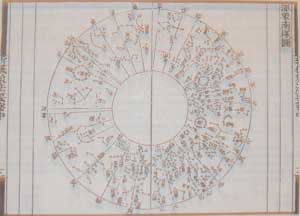
A south-polar projection star map from 1092 by Su Song, a Chinese scientist and mechanical engineer of the Song Dynasty (960-1279), from Su’s book known as the Xin Yi Xiang Fa Yao (Wade-Giles).
Pankenier, David Astrology and Cosmology in Early China: Conforming Earth to Heaven. 2013. Cambridge University Press. Shows how astronomy profoundly influenced every aspect of culture in the formative period, from art and architecture, to city planning, to political and military decision-making.
Park, Changbom Astronomy: Traditional Korean Science. 2008, Ewha Womans University Press. A historical study.
Peng, Eric “China’s Race to Study the Cosmos” in Astronomy, Mar. 2013, p. 44. Modern astronomical instruments China plans to build and projects it is joining with other countries to do.
Schafer, Edward Pacing the Void: Tang Approaches to the Stars. 2006, Floating World Editions [1977]. Chinese astral lore in the literature, religion, and folkways of the Tang Dynasty (618-907).
Sinnott, Roger “Japan’s Zany Passion for Telescopes,” in Sky & Telescope, March 1992, pp. 267-273.
Spitz, Anna “Visiting the Moon Lady” in Mercury, Jul/Aug. 2006, p. 24. On Chinese moon legends and how they continue to be used in cultural celebrations.
Sun, Xiaochun and Jacob Kistemaker The Chinese Sky During the Han: Constellating Stars and Society. 1997, Brill. Reconstructs the appearance and understanding of the sky in Han time (206 BC – AD 220). Technical in parts (chapter on the dating of positional observations) but excellent introduction to the history of mapping the sky in China (and East Asia).
Tseng, Lilian Lan-ying Picturing Heaven in Early China. 2011, Harvard East Asia Center. Stunning Han Dynasty visual representations of the celestial, in cosmology, mythology, and astronomy.
Vowahsen, Andreas Cosmic Architecture in India. 2001, Prestel. On the astronomical and ceremonial observatories built by Jai Singh in the 17th & 18th centuries.
Websites and Articles on the Web:
History of Chinese Astronomy: http://idp.bl.uk/4DCGI/education/astronomy/history.html (click on the next pages for more)

Frank Shu, born in China, educated at MIT and Harvard, holds appointments as professor of astronomy at the University of California, Berkeley and University of California, San Diego and the university president of the National Tsing Hua University.
The Mathematics of the Chinese Calendar (by Helmer Aslaksen of the National University of Singapore): http://www.math.nus.edu.sg/aslaksen/calendar/chinese.shtml
Copernicus in China (on the spread of Copernican ideas by Nathan Sivin of the University of Pennsylvania): http://ccat.sas.upenn.edu/~nsivin/cop.pdf
Japanese Star Lore Around Orion: http://www.renshaworks.com/jastro/orion.htm
The Lunar Calendar in Japan: http://www.renshaworks.com/jastro/calendar.htm
Korean Astronomy (brief article from Mercury magazine): http://www.astrosociety.org/pubs/mercury/9903/korea.html
Nha, I.-S. “Korean Astronomy” from a 1997 volume in the ASP Conference Series: http://adsabs.harvard.edu/full/1997ASPC..130..313N
Bibliography of Korean Astronomy: http://www.hawaii.edu/korea/biblio/sci_astronomy.html (This is a nice list of articles, but mostly in scholarly journals.)
Astronomy of India (Leslie Welser): http://www.starteachastronomy.com/indian.html
Aspects of Prehistoric Astronomy in India (a somewhat
technical article by N.K. Rao):
http://bulletin.astron-soc.in/05December/3305499-511.pdf
Acknowledgements: I am very grateful to Claudia Alexander, David Bruning, David Dearborn, Jarita Holbrook, Hyun-chul Lee, Bryan Mendez, Dara Norman, David Pankenier, Phil Sakimoto, Jessica
Santascoy, Cary Sneider, Keivan Stassun and others for suggesting entries for this list. I also thank Haverford student Miriam Lamb for summer research in connection with this guide.
Appendix A: Astronomy of Ancient European Cultures
Selected Published Materials:
Burl, Aubrey The Stone Circles of Britain, Ireland, and Brittany. 2000, Yale University Press. Detailed guide to Stonehenge and other ancient stone monuments.
Cunningham, Clifford “The Scottish Moon” in Mercury (the magazine of the Astronomical Society of the Pacific), Jul/Aug. 2006, p. 10. On the Callanish stones off the coast of Scotland their alignments with the motion of the Moon in the sky.
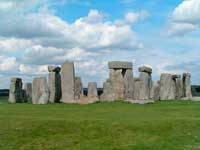
Stonehenge. Photo by Stefan Kuhn 2004
Gingerich, Owen “The Basic Astronomy of Stonehenge” in The Great Copernicus Chase. 1992, Cambridge U. Press. Uses a wonderful Coca-Cola can model to explain how the builders thought of the sky.
Krupp, E.C. “Inner Glow” in Sky & Telescope, Dec. 2004, p. 50. About the underground shrine at Newgrange, Ireland.
Maranto, G. “Stonehenge: Can It Be Saved?” in Discover, Dec. 1985,
p. 60. On what tourism is doing to the ancient monument.
Zimmermann, L. “Heads and Tales of Celestial Coins” in Sky & Telescope, Mar. 1995, p. 28. On astronomical events depicted on Roman coins.
In addition, see many of the books suggested in section 1 of this Guide.
Selected Websites and Articles on the Web:
Archaeoastronomy at Stonehenge: http://witcombe.sbc.edu/sacredplaces/stonehenge.html (an art historian examines Stonehenge
from many perspectives, including the astronomical)
Stone Pages: http://www.stonepages.com/ (Mammoth web catalog about European stone circles and monuments, including Stonehenge and others with astronomy connections.)
Appendix B: Reports and Articles on Achieving Greater Diversity in Science in General
American Astronomical Society Recommendations for Inclusive Astronomy: https://docs.google.com/document/d/1JipEb7xz7kAh8SH4wsG59CHEaAJSJTAWRfVA1MfYGM8/edit
Elmegreen, D. “Strategies for Improving Diversity: A Summary of the AIP Assembly of Society Officers Meeting (2013): http://aas.org/posts/news/2013/04/strategies-improving-diversity-summary-aip-assembly-society-officers-meeting
“Expanding Underrepresented Minority Participation: America’s Science and Technology Talent at the Crossroads” (2011 National Academy of Sciences Report): http://www.nap.edu/catalog.php?record_id=12984
Land of Plenty: Diversity as America’s Competitive Edge in Science, Engineering and Technology (2000, The Congressional Commission on the Advancement of Women and Minorities in Science, Engineering and Technology Development, via NSF): http://www.nsf.gov/pubs/2000/cawmset0409/cawmset_0409.pdf
Lee, Okhee & Buxton, Cory Diversity and Equity in Science Education: Research, Policy, and Practice. 2010, Teacher’s College Press.
Norman, Dara, et al. “Increasing the Number of Underrepresented Minorities in Astronomy” (a 2009 position paper for the decadal survey): http://csma.aas.org/Norman_minorityexe_DEM_EPO.pdf
Nota, Antonella, et al. “Diversifying the Next Generation of Astronomers One Institution at a Time” (a white paper submitted to the 2010 decadal survey for astronomy): http://www.aura-astronomy.org/diversity/documents/White%20Paper%20for%20Decadal%20Survey%20NOTA.pdf
Stassun, K. “Enhancing Diversity in Astronomy: Minority-Serving Institutions and REU Programs (a white paper on strategies and recommended actions): http://aas.org/archives/BAAS/v35n5/stassun.pdf
Stassun, K., et al. “The Fisk-Vanderbilt Master’s-to-Ph.D. Bridge Program: Recognizing, Enlisting, and Cultivating Unrealized or Unrecognized Potential in Underrepresented Minority Students” in American Journal of Physics, Vol. 79, No. 4 (April 2011). On the web at: ttp://www.vanderbilt.edu/gradschool/bridge/Stassun_AJP_2011_combined.pdf